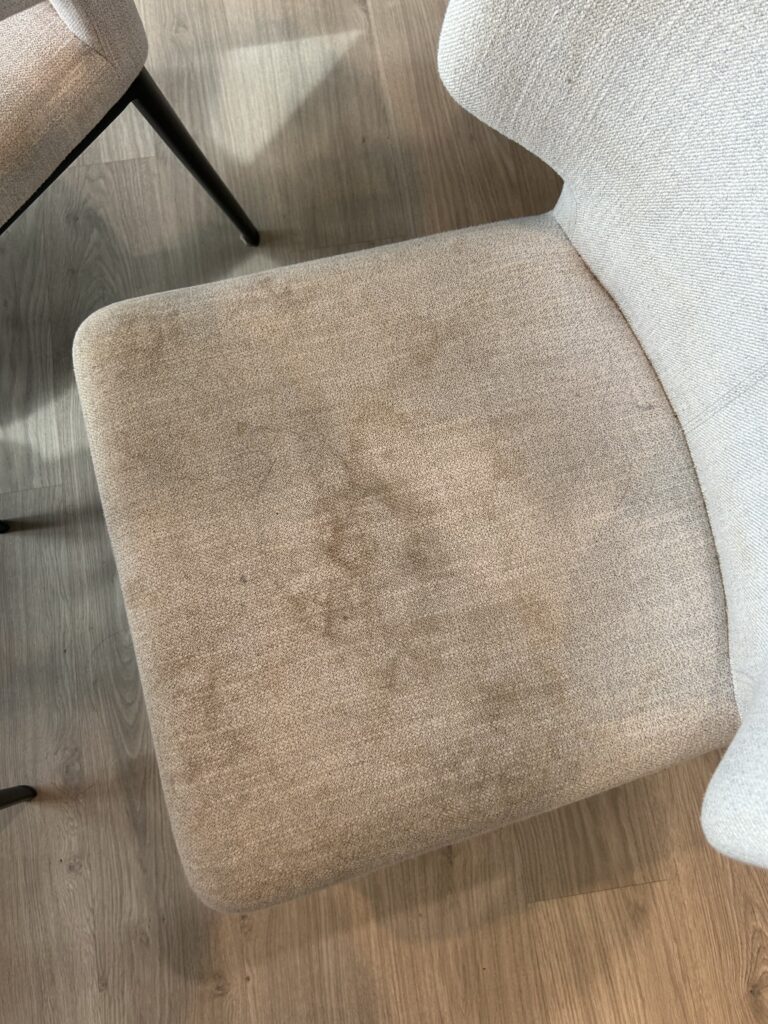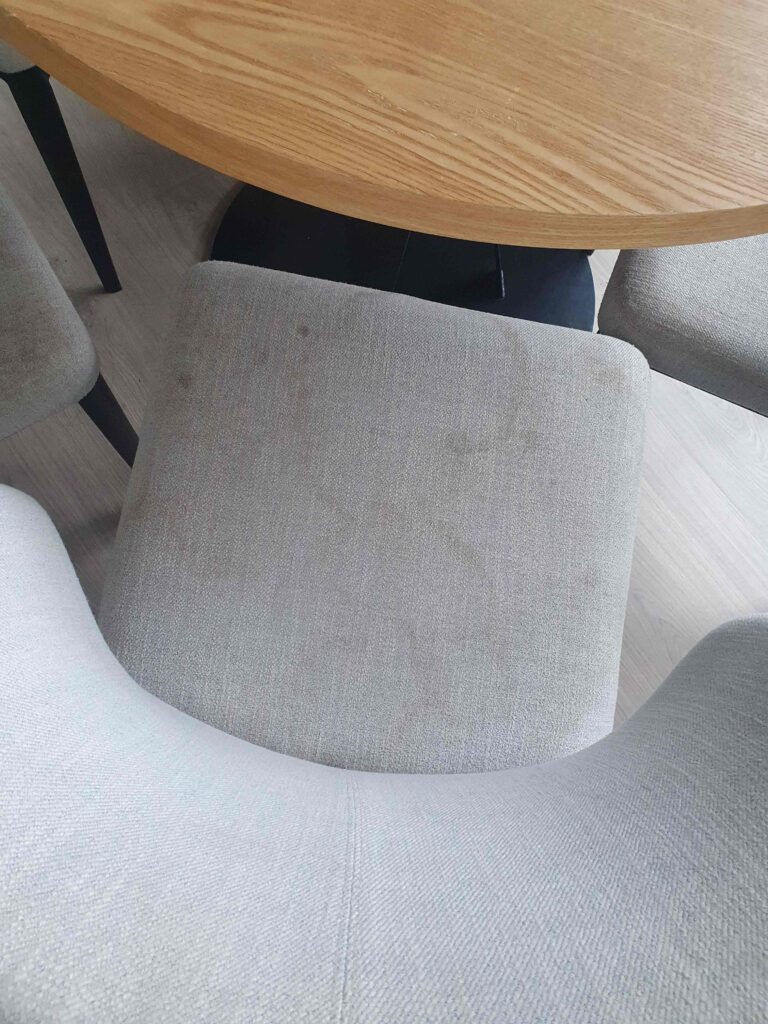Your cloth couch is probably one of the most-used pieces of furniture in your home. Every day, it deals with spills, dust, pet hair, food crumbs, and everyday wear and tear. Over time, all this usage can make your beautiful fabric sofa look tired and dirty. The good news is that cleaning a cloth couch doesn’t have to be complicated or expensive.
Regular cleaning of your fabric couch brings amazing benefits to your home. First, it removes allergens, dust mites, and bacteria that can affect your family’s health. Second, proper cleaning fabric sofa maintenance extends its lifespan, saving you money in the long run. Third, a fresh, clean couch instantly makes your living room look and smell better. Whether you’re dealing with everyday dirt or stubborn stains, knowing how to clean a couch properly makes all the difference.
You have two main options when it comes to couch cleaning: doing it yourself or hiring professionals. DIY cleaning works great for regular maintenance and minor stains, plus it’s budget-friendly. Professional couch cleaning Sydney services are perfect for deep cleaning, tough stains, or when you want expert results. In this guide, End of lease cleaning Sydney walk you through everything you need to know about cleaning cloth couch surfaces, so you can decide what works best for your situation.
What You’ll Need
Before you start cleaning your fabric sofa, gather all your sofa cleaning tools and supplies. Having everything ready makes the job faster and easier.
Here’s your essential cleaning toolkit:
- Vacuum cleaner with upholstery attachment: This is your most important tool for removing loose dirt, crumbs, and pet hair from your cloth couch. The upholstery attachment has a softer brush that won’t damage your fabric.
- Mild dish soap or upholstery cleaner: Choose a gentle cleaning solution that’s safe for fabric. Regular dish soap works wonderfully when mixed with water, or you can buy specialized upholstery cleaner from any store.
- White vinegar & baking soda: These natural cleaners are amazing for removing odors and treating stains. They’re safe, non-toxic, and probably already in your kitchen.
- Soft brush and microfiber cloths: A soft-bristled brush helps work cleaning solutions into the fabric without damaging it. Microfiber cloths are perfect because they’re absorbent and won’t leave lint behind.
- Spray bottle and warm water: You’ll use this to apply cleaning solutions evenly across your couch surface.
- Towels or absorbent cloths: Keep plenty of these handy for blotting spills and drying your couch after cleaning.
Having these sofa cleaning tools ready means you won’t have to stop mid-cleaning to search for supplies. This simple preparation makes the entire process of cleaning fabric sofa much smoother.
Step-by-Step Guide to Cleaning a Cloth Couch
Step 1: Check the Care Tag
Before you start cleaning your fabric couch, always check the manufacturer’s care tag first. This small tag is usually hidden under the cushions or on the bottom of your couch, and it contains crucial information.
Look for these fabric codes:
- W (Water-based cleaner): You can safely use water and water-based cleaning solutions on this fabric. This is the easiest type to clean.
- S (Solvent-based cleaner): This fabric needs special dry-cleaning solvents. Water can damage or stain it, so be careful.
- WS (Water or Solvent): Good news! You can use either water-based or solvent based cleaners on this type.
- X (Vacuum only): This delicate fabric shouldn’t be cleaned with any liquids. Stick to vacuuming only, or call professionals.
Understanding how to clean a fabric couch starts with respecting these codes. Using the wrong cleaner can cause permanent damage, discoloration, or water stains. When in doubt, test any cleaning solution on a hidden spot first, like the back corner of your couch. This simple step can save you from costly mistakes.
Step 2: Vacuum the Surface
Vacuuming is the foundation of cleaning cloth couch surfaces properly. Remove all cushions and pillows from your fabric sofa first. Use your vacuum cleaner with the upholstery attachment to thoroughly clean every surface.
Pay special attention to:
- Crevices between cushions where crumbs hide.
- Seams and piping where dust accumulates.
- Under and behind cushions.
- Armrests and the back of the couch.
Run the vacuum slowly across the fabric to pick up pet hair, dirt, and dust particles. For stubborn pet hair, try using a lint roller first or wear a slightly damp rubber glove and run your hand over the surface. The static electricity helps collect the hair.
Don’t rush this step! Proper vacuuming removes about 80% of the dirt on your couch. This sofa cleaning tool makes the rest of your cleaning much more effective because you’re not just pushing dirt around with your cloth.
Step 3: Pre-Treat Stains
Now it’s time to tackle those stubborn spots. The best way to clean fabric couch stains is to treat them before doing your overall cleaning.
- For mild stains: Mix one tablespoon of mild dish soap with two cups of warm water. Dip a clean microfiber cloth into the solution, wring it out well, and gently blot the stain. Never scrub aggressively, as this can damage the fabric fibers.
- For grease or oil stains: Sprinkle baking soda generously over the stain and let it sit for 15-20 minutes. The baking soda absorbs the oil. Then vacuum it up and treat any remaining residue with dish soap solution.
- For odor removal: Mix equal parts white vinegar and water in a spray bottle. Lightly mist the affected area (don’t soak it). Vinegar naturally neutralizes odors without leaving a strong smell once it dries.
Always blot stains from the outside toward the center to prevent them from spreading. Working on stains before cleaning your entire fabric sofa ensures better results and prevents set-in marks.
Step 4: Deep Clean the Fabric
This is where your cloth couch gets its thorough cleaning. Prepare your cleaning solution based on your fabric code. For most couches, mix a few drops of mild dish soap with warm water.
soak a microfiber cloth with cleaning solution and wring it thoroughly. The cloth should be moist and not soaking wet. This is crucial for how to clean a fabric couch without causing water damage.
Work in small sections, about two feet at a time. Gently wipe the fabric in circular motions, applying light pressure. This technique lifts dirt without pushing it deeper into the fibers.
Important tips for cleaning fabric sofa:
- Never over-wet the fabric.
- Work systematically from top to bottom.
- Overlap your cleaning sections slightly.
- Re-dampen your cloth as needed with fresh solution.
- Use a clean microfiber cloth for each new section if the old one gets dirty.
For clean microfiber couch surfaces, you might need to use a soft brush in circular motions to lift the nap and restore its texture after cleaning. Take your time with this step, as rushing can leave streaks or water marks.
Step 5: Rinse and Dry
After cleaning cloth couch surfaces, you need to remove any soap residue. Residue attracts dirt quickly, making your couch get dirty faster.
Wet a microfiber cloth with cleaning solution and wring it thoroughly. The cloth should be moist and not soaking wet.(not the soapy solution). Wring it out very well and wipe over all the areas you cleaned. This removes soap without re-wetting the fabric too much. Change to a fresh cloth and fresh water as needed.
Drying your fabric sofa properly:
- Open windows to increase air circulation.
- Point fans at the couch to speed drying.
- Never sit on the couch until it’s completely dry.
- Avoid direct heat sources like hair dryers, which can damage fabric.
- Fluff and rotate cushions once they’re dry.
Most cloth couches take 2-6 hours to air dry completely, depending on humidity and airflow. Proper drying prevents mildew growth and water stains. Once dry, vacuum again lightly to restore the fabric’s texture and remove any loosened dirt particles.
Natural Cleaning Alternatives
Many people prefer natural solutions when cleaning fabric sofa surfaces. These eco-friendly options are safe for families, pets, and the environment, plus they work remarkably well.
- Baking soda: is a miracle worker for cloth couches. It naturally absorbs odors, lifts light stains, and freshens fabric without chemicals. Sprinkle it generously over your entire couch, let it sit for 15-20 minutes (or overnight for strong odors), then vacuum thoroughly. For the best way to clean fabric couch odors, repeat monthly.
- White vinegar: is another powerhouse for cleaning cloth couch surfaces. Mix equal parts vinegar and water in a spray bottle. This solution disinfects, deodorizes, and breaks down stains naturally. The vinegar smell disappears as it dries, taking bad odors with it. Use this when cleaning fabric sofa that’s been exposed to smoke, pets, or food smells.
- Lemon essential oil: adds a fresh, natural scent after cleaning. Add 10-15 drops to your vinegar solution or mix with water in a spray bottle. Lightly mist your clean couch for a refreshing finish. Lemon also has natural antibacterial properties.
These natural methods are particularly great for families with children, pets, or anyone sensitive to chemical cleaners. They’re also much cheaper than commercial products while being just as effective for regular maintenance.
Preventive Maintenance Tips
The best way to clean fabric couch surfaces is to prevent them from getting too dirty in the first place. These simple habits keep your cloth couch looking fresh between deep cleanings.
- Vacuum weekly: using your upholstery attachment. This sofa cleaning tool removes surface dirt before it works its way deep into fabric fibers. A quick five-minute vacuum session prevents the need for intensive cleaning later.
- Rotate cushions regularly: ideally every week. This distributes wear evenly across all cushions, preventing some areas from looking more worn than others. It also helps cushions maintain their shape longer.
- Clean spills immediately: this cannot be stressed enough! Blot (never rub) fresh spills with a clean, dry cloth. The faster you act, the less likely the spill will become a permanent stain. Keep microfiber cloths nearby for quick action when accidents happen.
- Use washable covers or throws: as protection. Fabric sofa covers are lifesavers, especially if you have kids or pets. They’re easy to wash and protect your couch from daily wear. Choose covers that complement your décor so your couch still looks stylish.
These preventive steps extend the time between professional couch cleaning Sydney sessions and keep your fabric sofa looking newer for years. Prevention is always easier and cheaper than restoration.
When to Call Professionals
Sometimes DIY cleaning cloth couch methods aren’t enough, and that’s perfectly okay. Professional services have specialized equipment and expertise that deliver superior results in certain situations.
Call professionals when you face:
- Persistent stains that don’t respond to home treatments
- Deep-set odors that keep returning
- Large areas of discoloration
- Delicate fabrics with “S” or “X” care codes
- Heavy pet hair or allergen buildup
Professional couch cleaning Sydney services offer significant benefits. They use industrial-strength equipment that extracts more dirt and moisture than home methods. Their cleaning solutions are more powerful yet safe for various fabrics. They also understand how to clean a fabric couch of different types without causing damage.
Professional Advantages:
- Deep sanitization that kills bacteria and dust mites.
- Faster drying times with professional extraction equipment.
- Expert stain removal techniques.
- Fabric protection treatments that prevent future staining.
- Extended couch lifespan through proper care.
Sofa cleaning cost typically ranges from $100 to $300, depending on size and condition, which is reasonable considering the results and time saved. For best results, book a professional cloth couch cleaning service near you at least once a year. This keeps your fabric sofa in excellent condition while handling the intensive cleaning you can’t do at home.



Conclusion
Cleaning cloth couch surfaces doesn’t have to be overwhelming or expensive. By following these easy steps, you can keep your fabric sofa looking fresh, clean, and inviting for years to come. Remember the basics: check your care tag, vacuum regularly, treat stains quickly, and use the right cleaning solutions for your fabric type.
Whether you choose DIY methods or professional couch cleaning Sydney services, regular maintenance is key. A clean cloth couch improves your home’s hygiene, extends your furniture’s lifespan, and creates a more comfortable living space. The best way to clean fabric couch surfaces is consistently and carefully, using the proper techniques we’ve covered.
Start implementing these cleaning fabric sofa tips today, and you’ll notice an immediate difference. Your couch is an investment in your home’s comfort and style. Treat it well, and it will serve your family beautifully for many years. For daily updates visit to our social media channels such as Facebook, Instagram, Youtube and Twitter. A clean couch makes your home instantly more comfortable and inviting – and now you have all the knowledge you need to keep it that way!
FAQs About Cleaning a Cloth Couch
1. What is the best cleaner for cloth couches?
A mild dish soap solution or an upholstery-specific cleaner is ideal. Avoid bleach or harsh chemicals that can damage the fabric.
2. Can I use a steam cleaner on a cloth couch?
Yes, if your couch fabric label says “W” or “WS.” Always test a small area first to ensure colorfastness.
3. How often should I clean my cloth couch?
Vacuum weekly and deep clean every 3–6 months, depending on usage and household conditions (like pets or kids).
4. How do I remove pet odors from my cloth couch?
Sprinkle baking soda, let it sit for 15–20 minutes, and vacuum it off. You can also use a vinegar-water spray to neutralize odors.
5. What should I avoid when cleaning a cloth couch?
Avoid soaking the fabric, using too much soap, or scrubbing aggressively—these can damage fibers or cause water stains.
6. When should I hire a professional couch cleaner?
If the couch has deep stains, unpleasant odors, or delicate fabric that requires special care, a professional cleaner is recommended.



